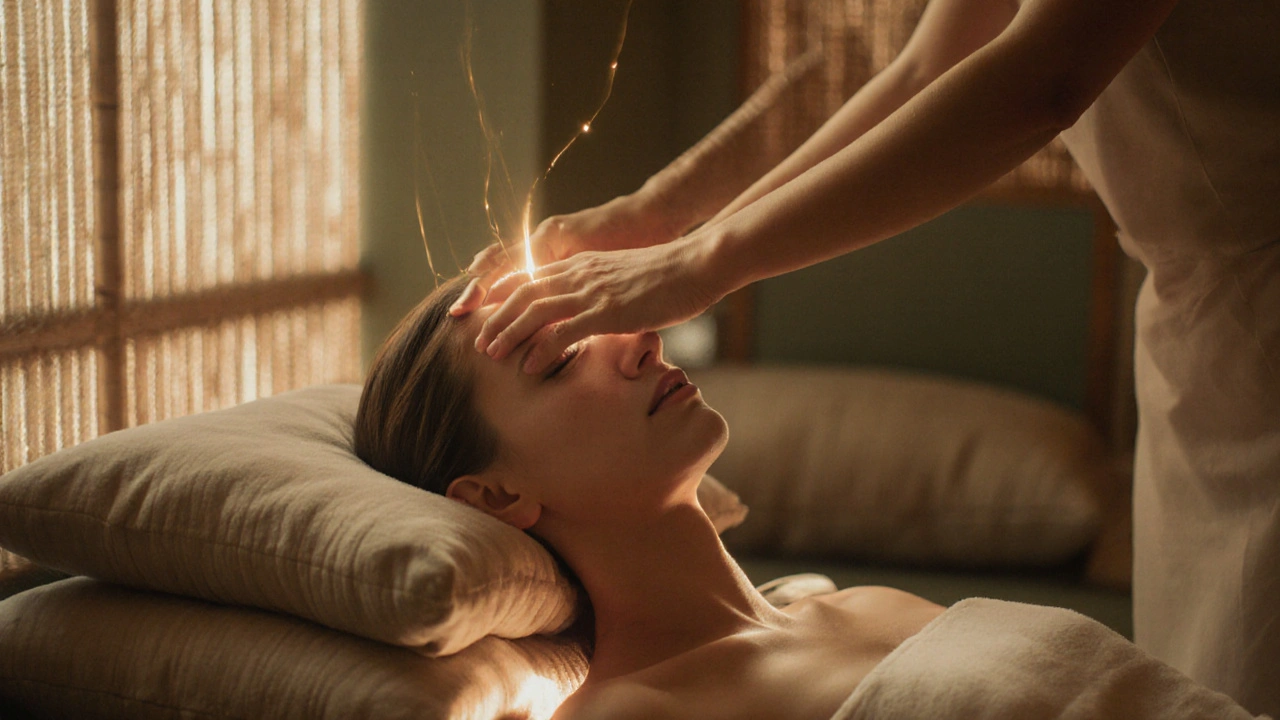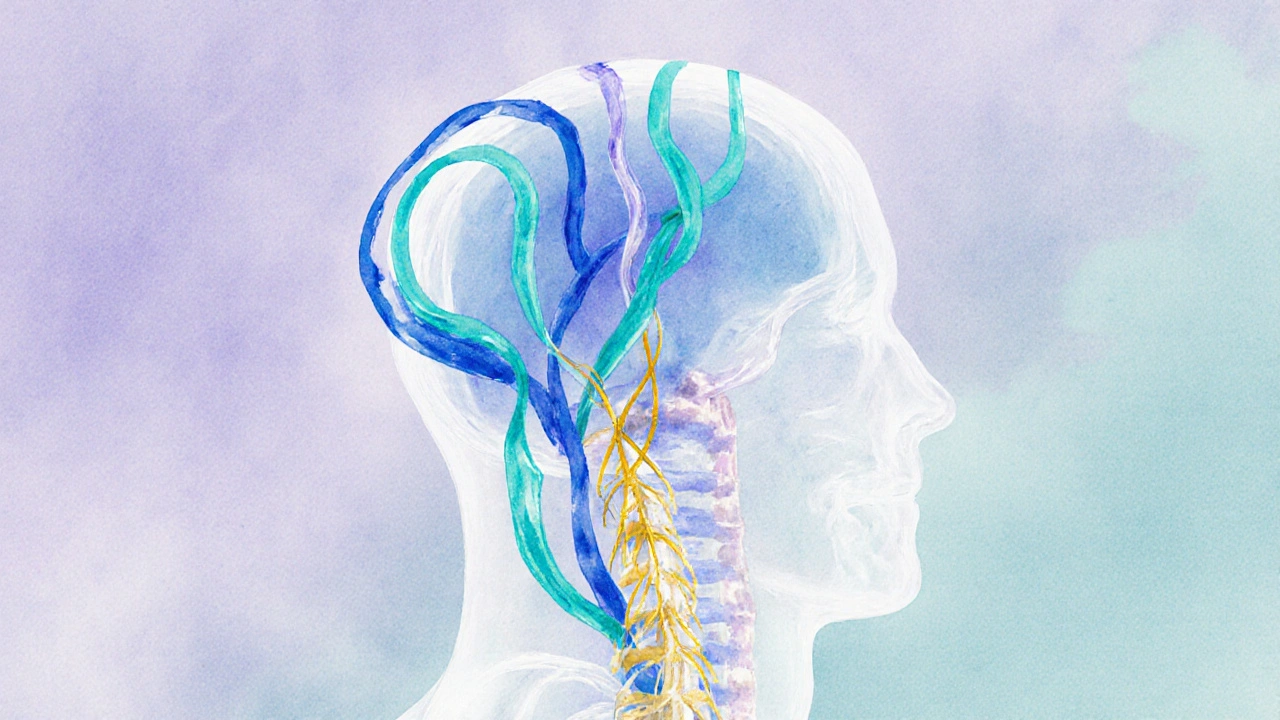What Does Indian Head Massage Unblock? A Full Guide

Ever wonder why a quick press on the crown can feel like a reset button for your whole body? Indian Head Massage isn’t just a pampering ritual - it actually clears blocked pathways that keep you feeling foggy, tense, or drained. Below you’ll get the low‑down on what it unblocks, how to book a session in London, why the buzz keeps growing, and what you’ll walk away feeling.
Quick Takeaways
- Unblocks blood flow, lymphatic drainage, and tension in scalp muscles.
- Boosts mental clarity, reduces stress hormones, and improves hair‑follicle health.
- Typical session: 30‑45minutes, £45‑£70 in London.
- Best for anyone feeling mental fatigue, headaches, or sluggish circulation.
What Is Indian Head Massage?
Indian Head Massage is a traditional Ayurvedic technique that focuses on the scalp, neck, and shoulders. It uses rhythmic thumb and fingertip pressure to stimulate nerve endings and release built‑up tension. The practice dates back centuries, originally meant to balance the body’s energy channels (or "nadis") and improve overall vitality.
This isn’t a full‑body deep tissue rub - it zeroes in on the scalp muscles and the connective tissue that links the head to the spine.
What Gets Unblocked?
Think of the head as a traffic hub. When certain routes get jammed, you feel it as a headache, brain fog, or even a dull ache in the neck. Indian Head Massage works like a traffic officer, opening up the following pathways:
- Blood circulation - Better flow brings oxygen and nutrients to brain cells, reducing fatigue.
- Lymphatic system - Improved drainage clears waste products, cutting down on swelling and inflammation.
- Tension in scalp and neck muscles - Release of tight knots eases chronic headache patterns.
- Stress hormones (cortisol) - Gentle pressure triggers the parasympathetic response, lowering cortisol levels.
- Energy flow - According to Ayurvedic theory, the massage clears blockages in the body's energy pathways, promoting a sense of balance.
When these blockages lift, you’ll notice sharper focus, fewer tension headaches, and a subtle boost in mood.

How to Get an Indian Head Massage in London
- Search for reputable salons or wellness centers that list Indian Head Massage as a service. Look for qualified therapists with Ayurvedic training.
- Check reviews for consistency - a 4‑star rating or higher on Google or Trustpilot is a good sign.
- Book a slot. Most places offer 30‑minute sessions for around £45 and 45‑minute sessions for £70.
- Arrive a few minutes early, avoid heavy meals, and let the therapist know any specific neck or head pain you’re dealing with.
- Relax and enjoy the rhythmic strokes. A typical session lasts 30‑45minutes and ends with a brief period of quiet to let the effects settle.
Many spas incorporate the massage into a broader wellness package (e.g., aromatherapy or foot reflexology). If you’re looking for a quick fix, a stand‑alone head massage works just fine.
Why It’s Gaining Popularity
Three main drivers are pushing Indian Head Massage into the mainstream:
- Stress epidemic - Office workers in London report record levels of mental fatigue. A short scalp session offers a fast‑track to calm.
- Hybrid work lifestyles - With more people sitting at desks for long hours, neck and scalp tension spikes. The massage directly targets those problem areas.
- Wellness tourism - Travelers from abroad seek authentic Ayurvedic experiences, and the head massage is an easy entry point.
Results are quick and noticeable, which fuels word‑of‑mouth referrals. In fact, a 2023 wellness survey found that 68% of respondents who tried the massage felt “significantly less stressed” after just one session.
How It Stacks Up Against Other Massages
| Benefit | Indian Head Massage | Swedish Full‑Body | Deep Tissue |
|---|---|---|---|
| Time required | 30‑45min | 60‑90min | 60‑90min |
| Cost (London average) | £45‑£70 | £70‑£120 | £80‑£130 |
| Focus on scalp/neck tension | High | Low | Low |
| Boosts blood circulation | Moderate | High | High |
| Improves lymphatic drainage | High | Low | Low |
| Reduces cortisol (stress hormone) | High | Moderate | Low |
When you weigh time, cost, and the specific goal of unblocking scalp tension, Indian Head Massage comes out on top for busy professionals.

What You’ll Feel After a Session
Clients typically report a mix of physical and mental sensations:
- Immediate light‑headedness - A gentle wave of relaxation that can feel like a “head tilt” sensation.
- Warmth in the scalp - Blood flow increases, giving a pleasant tingling.
- Reduced headache intensity - Frequency drops by up to 30% after a few regular sessions.
- Clearer thinking - Many describe a “mental fog lift” that lasts several hours.
- Improved hair shine - Better circulation feeds hair follicles, leaving strands looking healthier.
These effects are cumulative. A weekly schedule for a month can turn occasional relief into a baseline sense of well‑being.
Next Steps & Troubleshooting
If you’re new to the practice, start with a single 30‑minute session and note how you feel. Here’s a quick guide for different scenarios:
- Feeling groggy after the massage? Drink water and stay upright for 10minutes - it helps the lymphatic system finish its work.
- Persistent neck pain? Ask the therapist to focus more on the trapezius and upper shoulder area; they can adjust pressure levels.
- Hair scalp irritation? Ensure the therapist uses light, hypoallergenic oils; avoid heavy scented products right after.
Stick with a routine of 1‑2 sessions per week and track changes in headache frequency, sleep quality, and mental sharpness. Over time you’ll see the blockages dissolve.
Frequently Asked Questions
Is Indian Head Massage safe for everyone?
Generally yes. People with recent head injuries, open wounds, or severe skin conditions should avoid it or get a doctor’s OK first.
How often should I book a session?
For noticeable results, 1‑2 times a week for the first month, then maintain with a weekly session.
Can it replace my regular fitness routine?
No. It’s a complementary therapy that helps with recovery and mental clarity, but it doesn’t provide cardiovascular benefits.
What oils are typically used?
Sesame, coconut, or almond oil are common. Therapists choose based on skin type and client preference.
Will it help with hair loss?
It can improve scalp health and circulation, which may support hair growth, but it’s not a cure for genetic hair loss.
Ready to clear the mental and physical blockages that keep you stuck? Book a certified Indian Head Massage therapist in London today and feel the difference for yourself.






